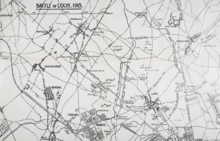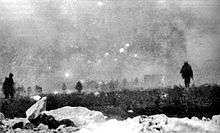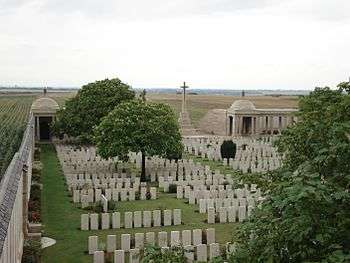Battle of Loos
| ||||||||||||||||||||||||||||||
The Battle of Loos was a World War I battle that took place from 25 September – 13 October 1915 in France on the Western Front, during the First World War. It was the biggest British attack of 1915, the first time that the British used poison gas and the first mass engagement of New Army units. The French and British tried to break through the German defences in Artois and Champagne and restore a war of movement. Despite improved methods, more ammunition and better equipment, the Franco-British attacks were contained by the German armies, except for local losses of ground. British casualties at Loos were about twice as high as German losses.
Background
Strategic developments
The battle was the British part of the Third Battle of Artois, an Anglo-French offensive (known to the Germans as the Herbstschlacht (Autumn Battle). Field Marshal Sir John French and Haig (GOC First Army), regarded the ground south of La Bassée Canal, which was overlooked by German-held slag heaps and colliery towers, as unsuitable for an attack, particularly given the discovery in July, that the Germans were building a second defensive position behind the front position. At the Frévent Conference on 27 July, Field Marshal French failed to persuade Ferdinand Foch that an attack further north offered greater prospects for success. The debate continued into August with Joffre siding with Foch and the commanders being over-ruled by Herbert Kitchener, the British Secretary of State for War, on 21 August.[1] On 3 May, the British decided upon use of poison gas in military operations in France. At a conference on 6 September, Haig announced to his subordinates that extensive use of chlorine gas might facilitate success despite the terrain, if the French and British were able to keep the attack secret and advance on a line towards Douai and Valenciennes.[2]
Prelude
British offensive preparations
The battle was the third time that specialist Royal Engineer tunnelling companies, were used to tunnel under no-man's-land, to plant mines under the parapets of the German front line trenches, to be detonated at zero hour.[3]
British plan of attack

French decided to keep a strong reserve consisting of the Cavalry Corps, the Indian Cavalry Corps and XI Corps (Lieutenant-General Richard Haking), which consisted of the Guards Division and the New Army 21st Division and 24th Division, which had recently arrived in France and a corps staff (some of whom had never worked together or served on a staff before). Archibald Murray, the Deputy Chief of the Imperial General Staff (DCIGS) advised French that as troops fresh from training, they were suited for the long marches of an exploitation rather than for trench warfare. French was doubtful that a breakthrough would be achieved. Haig and Foch, commander of the groupe des armées du nord (Northern Army Group), wanted the reserves closer, to exploit a breakthrough on the first day; French agreed to move them nearer to the front but still thought they should not be committed until the second day.[4]
Haig was hampered by the shortage of artillery ammunition, which meant the preliminary bombardment, essential for success in trench warfare, was insufficient. Prior to the British attack, about 140 long tons (140,000 kg) of chlorine gas was released with mixed success; in places the gas was blown back onto British trenches. Due to the inefficiency of contemporary gas masks, many soldiers removed them as they could not see through the fogged-up eyepieces or could barely breathe with them on, which led to some soldiers being affected by the British gas as it blew back. Wanting to be closer to the battle, French had moved to a forward command post at Lilliers, less than 20 miles (32 km) behind the First Army front. He left most of his staff behind at GHQ and had no direct telephone to the First Army, which attacked at 6:30 a.m. on 25 September and he sent an officer by car requesting release of the reserves at 7:00 a.m.[5]
Battle
25 September

In many places British artillery had failed to cut the German wire in advance of the attack.[6] Advancing over open fields, within range of German machine guns and artillery, British losses were devastating.[7] The British were able to break through the weaker German defences and capture the town of Loos-en-Gohelle, mainly due to numerical superiority. Supply and communications problems, combined with the late arrival of reserves, meant that the breakthrough could not be exploited. Haig did not hear until 10:00 a.m. that the divisions were moving up to the front. French visited Haig from 11:00 to 11:30 a.m. and agreed that Haig could have the reserve but rather than using the telephone he drove to Haking's headquarters and gave the order at 12:10 p.m. Haig then heard from Haking at 1:20 p.m. that the reserves were moving forward.[5]
26–28 September
When the battle resumed the following day, the Germans had recovered and improved their defensive positions. British attempts to continue the advance with the reserves were repulsed.[8] Twelve attacking battalions suffered 8,000 casualties out of 10,000 men in four hours.[5] French told Foch on 28 September, that a gap could be "rushed" just north of Hill 70, although Foch felt that this would be difficult to co-ordinate and Haig told him that the First Army was in no position for further attacks.[9] A lull fell on 28 September, with the British having retreated to their starting positions, having lost over 20,000 casualties, including three major-generals.[lower-alpha 1]
Air operations
The Royal Flying Corps (RFC) came under the command of Brigadier-General Hugh Trenchard.[10] The 1st, 2nd and 3rd wings under Colonels E. B. Ashmore, John Salmond and Sefton Brancker participated. As the British were short of artillery ammunition, the RFC flew target identification sorties prior to the battle, to ensure that shells were not wasted.[11] During the first few days of the attack, target-marking squadrons equipped with better wireless transmitters, helped to direct British artillery onto German targets.[12] Later in the battle, pilots carried out a tactical bombing operation for the first time in history. Aircraft of the 2nd and 3rd wings dropped many 100-pound (45 kg) bombs on German troops, trains, rail lines and marshalling yards.[13] As the land offensive stalled, British pilots and observers flew low over German positions, providing target information to the artillery.[14]
Aftermath
Analysis

Rawlinson wrote to the King's adviser Stamfordham (28 September)
From what I can ascertain, some of the divisions did actually reach the enemy's trenches, for their bodies can now be seen on the barbed wire.— Rawlinson[5]
Major-General Richard Hilton, at that time a Forward Observation Officer, said of the battle:
A great deal of nonsense has been written about Loos. The real tragedy of that battle was its nearness to complete success. Most of us who reached the crest of Hill 70, and survived, were firmly convinced that we had broken through on that Sunday, 25th September 1915. There seemed to be nothing ahead of us, but an unoccupied and incomplete trench system. The only two things that prevented our advancing into the suburbs of Lens were, firstly, the exhaustion of the "Jocks" themselves (for they had undergone a bellyfull of marching and fighting that day) and, secondly, the flanking fire of numerous German machine-guns, which swept that bare hill from some factory buildings in Cite St. Auguste to the south of us. All that we needed was more artillery ammunition to blast those clearly-located machine-guns, plus some fresh infantry to take over from the weary and depleted "Jocks." But, alas, neither ammunition nor reinforcements were immediately available, and the great opportunity passed.— Richard Hilton[15]
The twelve attacking battalions suffered 8,000 casualties out of 10,000 men in four hours.[5] French had already been criticised before the battle and lost his remaining support in the government and army because of the British failure and his perceived poor handling of the reserve divisions.[16] French was replaced by Haig as Commander of the British Expeditionary Force (BEF) in December 1915.[17]
Casualties
British casualties in the main attack were 48,367 and they suffered 10,880 more in the subsidiary attack, a total of 59,247 losses of the 285,107 British casualties on the Western Front in 1915.[18] J. E. Edmonds, the British Official Historian, gave German losses in the period 21 September – 10 October as c. 26,000 of c. 141,000 casualties on the Western Front during the autumn offensives in Artois and Champagne.[19] In Der Weltkrieg, the German official account, losses of the German 6th Army are given as 29,657 to 21 September; by the end of October losses had risen to 51,100 men and total German casualties for the autumn battle (Herbstschlacht) in Artois and Champagne, were given as 150,000 men.[20]
Subsequent operations
3–13 October
The Germans made several attempts to recapture the Hohenzollern Redoubt, which they accomplished on 3 October.[21] On 8 October, the Germans attempted to recapture much of the remaining lost ground by attacking with five regiments around Loos and against part of the 7th Division on the left flank. Foggy weather inhibited observation, the artillery preparation was inadequate and the British and French defenders were well prepared behind intact wire. The German attack was repulsed with 3,000 casualties but managed to disrupt British attack preparations, causing a delay until the night of 12/13 October.[22][23] The British made a final attack on 13 October, which failed due to a lack of hand grenades.[24] Haig thought it might be possible to launch another attack on 7 November but the combination of heavy rain and accurate German shelling during the second half of October persuaded him to abandon the attempt.[25]
Commemoration

The Loos Memorial commemorates over 20,000 soldiers of Britain and the Commonwealth who fell in the battle and have no known grave.[26] The community of Loos in British Columbia, changed its name to commemorate the battle and several participants wrote of their experiences, Robert Graves described the battle and succeeding days in his war memoir Goodbye to All That (1929), Patrick MacGill, who served as a stretcher-bearer in the London Irish and was wounded at Loos in October 1915, described the battle in his autobiographical novel The Great Push (1916) and J. N. Hall related his experiences in the British Army at Loos in Kitchener's Mob (1916).[27][28][29]
Victoria Cross awards
- Daniel Laidlaw, 7th (Service) Battalion, King's Own Scottish Borderers.[30]
- Frederick Henry Johnson, 73rd Field Company, Corps of Royal Engineers, 15th Division.[31]
- Harry Wells, 2nd Battalion Royal Sussex Regiment.[32]
- Anketell Moutray Read, 1st Battalion, Northamptonshire Regiment (posthumous).[32]
- Henry Edward Kenny, 1st Battalion, Loyal North Lancashire Regiment.[32]
- George Stanley Peachment, 2nd Battalion, King's Royal Rifle Corps.[32]
- Arthur Vickers, 2nd Battalion, Royal Warwickshire Regiment.[33]
- George Maling, Royal Army Medical Corps.[34]
- Kulbir Thapa, 2nd Battalion, 3rd Queen Alexandra's Own Gurkha Rifles.[34]
- Rupert Price Hallowes, 4th Battalion, Middlesex Regiment.[35]
- Angus Falconer Douglas-Hamilton, 6th (Service) Battalion, Queen's Own Cameron Highlanders.[36]
- Arthur Frederick Saunders, 9th (Service) Battalion, Suffolk Regiment.[37]
- Robert Dunsire, 13th (Service) Battalion, Royal Scots.[38]
- James Dalgleish Pollock, 5th (Service) Queen's Own Cameron Highlanders.[39]
- Alexander Buller Turner, 3rd Battalion, Royal Berkshire Regiment (posthumous).[40]
- Alfred Alexander Burt, 1/1st Battalion, Hertfordshire Regiment.[41]
- Arthur Fleming-Sandes, 2nd Battalion, East Surrey Regiment.[42]
- Samuel Harvey, 1st Battalion, York and Lancaster Regiment.[42]
- Oliver Brooks, 3rd Battalion, Coldstream Guards.[43]
- James Lennox Dawson, 187th Company, Corps of Royal Engineers.[44]
- Geoffrey Vickers, Sherwood Foresters (Nottinghamshire and Derbyshire Regiment).[44]
See also
Notes
Footnotes
- ↑ Edmonds 1928, pp. 120–129.
- ↑ Edmonds 1928, pp. 151–154.
- ↑ Edmonds 1928, pp. 162, 252–263.
- ↑ Holmes 1981, pp. 300–302.
- 1 2 3 4 5 Holmes 1981, pp. 302–305.
- ↑ Edmonds 1928, pp. 163–167.
- ↑ Edmonds 1928, pp. 191, 207, 223, 258, 261, 264.
- ↑ Edmonds 1928, pp. 304–307.
- ↑ Holmes 1981, pp. 305–306.
- ↑ Jones 1928, p. 124.
- ↑ Jones 1928, p. 125.
- ↑ Jones 1928, pp. 129–130.
- ↑ Jones 1928, pp. 127–128.
- ↑ Boyle 1962, pp. 148–150.
- ↑ Warner 1976, pp. 1–2.
- ↑ Holmes 1981, pp. 306–310.
- ↑ Edmonds 1928, p. 409.
- ↑ Edmonds 1928, pp. 392–393.
- ↑ Edmonds 1928, p. 392.
- ↑ Humphries & Maker 2010, pp. 308, 320, 329.
- ↑ Edmonds 1928, pp. 369–370.
- ↑ Edmonds 1928, pp. 372–375.
- ↑ Humphries & Maker 2010, p. 319.
- ↑ Edmonds 1928, pp. 380–387.
- ↑ Edmonds 1928, pp. 389–391.
- ↑ CWGC 2013.
- ↑ Graves 1929, pp. 141–172.
- ↑ MacGill 1916, pp. 118–168.
- ↑ Hall 1916, pp. 146–168.
- ↑ Edmonds 1928, p. 194.
- ↑ Edmonds 1928, p. 205.
- 1 2 3 4 Edmonds 1928, p. 214.
- ↑ Edmonds 1928, p. 231.
- 1 2 Edmonds 1928, p. 261.
- ↑ Edmonds 1928, p. 264.
- ↑ Edmonds 1928, p. 327.
- ↑ Edmonds 1928, p. 333.
- ↑ Edmonds 1928, p. 336.
- ↑ Edmonds 1928, p. 353.
- ↑ Edmonds 1928, p. 354.
- ↑ Edmonds 1928, p. 361.
- 1 2 Edmonds 1928, p. 369.
- ↑ Edmonds 1928, p. 374.
- 1 2 Edmonds 1928, p. 387.
References
- Books
- Boyle, A. (1962). Trenchard Man of Vision. London: Collins. OCLC 752992766.
- Edmonds, J. E. (1928). Military Operations France and Belgium, 1915: Battles of Aubers Ridge, Festubert, and Loos. History of the Great War Based on Official Documents By Direction of the Historical Section of the Committee of Imperial Defence. II (1st ed.). London: Macmillan. OCLC 58962526.
- Graves, R. (1980) [1957]. Goodbye to All That (Penguin ed.). London: Cassell. ISBN 0-14-00-1443-8.
- Hall, J. N. (1916). Kitchener's Mob: The Adventures of an American in the British Army (PDF) (1st ed.). Boston: Houghton Mifflin. OCLC 1194374. Retrieved 15 July 2013.
- Holmes, R. (2005) [1981]. The Little Field Marshal. A Life of Sir John French (Cassell Military Paperbacks ed.). London: Jonathan Cape. ISBN 978-0-304-36702-3.
- Jones, H. A. (2002) [1928]. The War in the Air, Being the Story of the Part Played in the Great War by the Royal Air Force (PDF). History of the Great War Based on Official Documents By Direction of the Historical Section of the Committee of Imperial Defence. II (Imperial War Museum and Naal & Military Press ed.). London: Clarendon Press. ISBN 1-84342-413-4. Retrieved 29 March 2015.
- MacGill, P. (1916). The Great Push: An Episode of the Great War (PDF). New York: G. H. Doran. OCLC 655576627. Retrieved 15 July 2013.
- Humphries, M. O.; Maker, J. (2010). Germany's Western Front: Translations from the German Official History of the Great War. II (1st ed.). Waterloo Ont.: Wilfrid Laurier University Press. ISBN 978-1-55458-259-4.
- Warner, P. (2000) [1976]. The Battle of Loos (Wordsworth ed.). London: William Kimber. ISBN 1-84022-229-8.
- Journals
- "Second Supplement to the London Gazette" (29447). HMSO. 22 January 1916: 945. Retrieved 5 June 2014.
- Websites
- "Loos Memorial". Commonwealth War Graves Commission. OCLC 813744927. Retrieved 10 September 2013.
Further reading
- Books
- Bolwell, F. A. (1917). With a Reservist in France (A Personal Account of All the Engagements in Which the 1st Division 1st Corps Took Part, viz; Mons (including the retirement), the Marne, the Aisne, First Battle of Ypres, Neuve Chapelle, Festubert and Loos) (PDF). New York: Dutton. OCLC 1894557. Retrieved 13 September 2013.
- O'Dwyer, M. F. (1918). War Speeches (PDF). Lahore: Superintendent Government Printing. OCLC 697836601. Retrieved 15 July 2013.
- Warner, P. (1976). The Battle of Loos. London: HarperCollins. OCLC 2962457.
- Theses
- Beach, J. (2004). British Intelligence and the German Army 1914–1918 (PhD). London: London University. OCLC 500051492. Retrieved 29 May 2015.
- Brown, I. M. (1996). The Evolution of the British Army's Logistical and Administrative Infrastructure and its Influence on GHQ's Operational and Strategic Decision-Making on the Western Front, 1914–1918 (PhD). London: London University. OCLC 53609664. Retrieved 29 May 2015.
- Peaple, S. P. (2003). The 46th (North Midland) Division T. F. on the Western Front, 1915–1918. Thesis (PhD). Birmingham: Birmingham University. OCLC 500351989. Retrieved 13 September 2013.
- Simpson, A. (2001). The Operational Role of British Corps Command on the Western Front 1914–18 (PhD). London: London University. ISBN 1-86227-292-1.
External links
| Wikimedia Commons has media related to Battle of Loos. |
- British Order of Battle Battle of Loos 1915
- Battle of Loos
- Battle of Loos
- Photograph collection
- CWGC: 1915: The Battle of Loos
- Recording 'Laidlaw's Last Lament' song by David Kilpatrick
